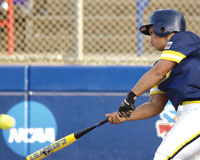NCAA News Archive - 2006
« back to 2006 | Back to NCAA News Archive Index
|
If the Division I Softball Committee has its way, 56 really will mean 56.
Committee members are recommending a new maximum-contest limit for the regular season. Previously, coaches were allowed to schedule games on 56 dates, which meant the number of contests played could creep into the 65- and 70-game or higher range because there was no limit on the number of games played on a certain date.
The recommendation would scale back the number of the games by counting each game in a tournament as one contest. The idea needs approval from the Division I Championships/Competition Cabinet before it can be implemented, but it already has support from the National Fastpitch Coaches Association.
The Mountain West Conference also has submitted a legislative proposal for the 2006-07 cycle that would count all games played during a tournament as one contest toward the maximum.
Committee members cite many benefits from the new approach. For example, many Northern teams travel early in the season to play games in warmer climates in hopes of being competitive with Southern schools. Many of those games are played during weekdays, which means missed class time for the student-athletes.
The softball committee, which met July 4-7 in Fort Lauderdale, Florida, believes reducing the number of contests will make weekend games a more common occurrence.
Members also believe that a 56-game limit would balance any competitive inequities. For instance, Northern institutions may not need to travel early in the season if they feel they are falling behind warmer-climate programs since there would still be room at the back end of the season to complete a schedule.
The tighter contest maximum also would help the selection process in that committee members wouldn’t have to compare teams that have a large discrepancy in the number of games played.
"We evaluate a lot of criteria during selections," said committee Chair Marianne Vydra, the associate athletics director and senior woman administrator at Oregon State University. "It is apparent that we had a lot of questions when it comes to looking at Rating Percentage Index that weighs heavily on wins and losses. When you have teams playing 50 games and other teams playing close to 80, it is a big difference. We support the new model because it is a way to level the playing field."
But making the process more manageable takes a backseat to student-athlete well-being.
"Softball misses so many class dates," Vydra said. "We want to make sure we’re not over-scheduling."
In action regarding the nontraditional segment, the committee is recommending that four dates of competition be allowed in the fall. A maximum of three games per date would be allowed.
"The coaches have recommended this because they hear that the student-athletes get tired of just practicing," Vydra said. "They think if they are allowed to play some local competition, it would break up the monotony."
Committee members also reviewed broadcast ratings data from ESPN representatives during their meeting.
Ratings for the 2006 Women’s College World Series were up 5 percent for games broadcast on ESPN2 and down 5 percent for contests appearing on ESPN.
More than 1.2 million viewers tuned into WCWS coverage on ESPN and more than 815,000 watched games on ESPN2.
ESPN’s family of networks expanded its coverage of the regional and super regional rounds. ESPN2 broadcast three regional games from three sites, and ESPNU showed all six games of the regional hosted by the University of California, Los Angeles.
Regular-season ratings for softball increased 23 percent on ESPN and 15 percent on ESPN2.
© 2010 The National Collegiate Athletic Association
Terms and Conditions | Privacy Policy

